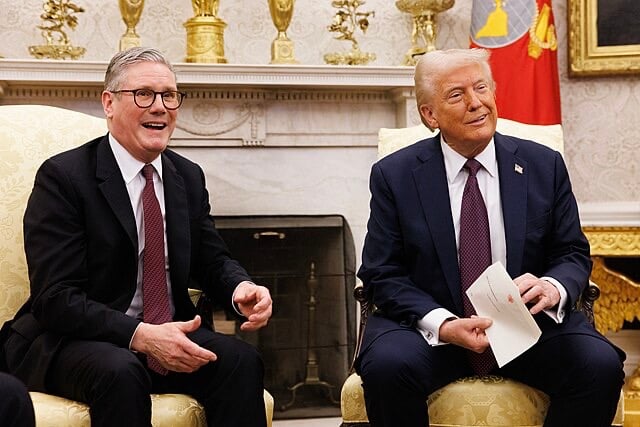Downing Street scrambles as 10% duties remain on British goods while PM backtracks on military spending promises needed to keep America onside
EXCLUSIVE: Donald Trump’s erratic tariff policies have cast fresh doubt over the UK-US “special relationship” as Downing Street appears caught off-guard by the President’s latest trade announcements – while Sir Keir Starmer faces mounting pressure over his refusal to commit to crucial defence spending increases.
The Prime Minister appeared on BBC Radio 4’s Today programme this morning unable to provide a firm date for when Britain would reach the 3% of GDP defence spending target that military chiefs say is essential – just hours before launching the government’s Strategic Defence Review.
In a stumbling interview, Starmer refused to commit to the timeline, despite Defence Secretary John Healey telling papers over the weekend he had “no doubt” the government would spend 3% on defence by 2034.
The tariff trap deepens
The uncertainty comes as Britain remains trapped in Trump’s web of ever-changing tariff policies, with the 10% baseline duty on UK goods still firmly in place despite May’s much-trumpeted “historic” trade deal.
That agreement – which Trump called a “great deal for America” – left British exporters facing continued 10% tariffs on most goods, a burden that economists warn could cost UK businesses billions annually.
Now, with Trump threatening 50% tariffs on the EU (delayed until July 9 after frantic negotiations) and his administration’s chaotic approach to trade policy sending markets into turmoil, UK officials are scrambling to understand where Britain stands.
The situation remains very fluid,” one Downing Street source admitted, with government insiders expressing frustration at the unpredictability of Trump’s trade agenda.
Defence spending dodge
The timing couldn’t be worse for Starmer, who is under intense pressure to prove Britain can meet Trump’s demands for European allies to drastically increase military spending.
On the Today programme, the Prime Minister’s evasiveness was painful to hear:
I am not, as the Prime Minister of a Labour Government, going to make a commitment as to the precise date, until I couldn’t be sure precisely where the money is coming from, how we can make good on that commitment.
This despite the authors of his own Strategic Defence Review writing that the government’s decision to raise spending to 3% “made an enormous difference” and “established the affordability of our recommendations.
Industry observers warned that failing to lock in the full increase could leave the review’s 10-year programme underfunded before it has even begun.
“This is the danger with spending reviews based on assumed increases. If that increase doesn’t materialise, it’s just a wish list,” one former defence official told UK Defence Journal.
Trump’s 5% demand looms
The pressure is only set to intensify, with NATO preparing to push for members to commit to spending 5% of GDP on defence when it meets on June 24-25 – a target Trump has repeatedly championed.
Britain currently spends 2.33% of GDP on defence, having committed to reach 2.5% by 2027 through controversial cuts to international aid.
But with Trump suggesting European nations aren’t pulling their weight and threatening to abandon America’s security guarantees, the gap between Britain’s spending and Trump’s expectations grows ever wider.
A relationship in crisis
The combination of continued tariffs and defence spending uncertainty exposes the fragility of the UK-US relationship under Trump’s transactional approach to alliances.
Despite Starmer’s attempts to cozy up to the President – including offering to send British troops to Ukraine – the fundamentals remain unchanged:
- UK goods still face 10% tariffs with no timeline for removal
- Britain’s defence spending falls far short of Trump’s demands
- The chaotic nature of Trump’s trade policy makes long-term planning impossible
As one UK official noted about the May trade deal: “This is not a finished, classic ‘bells and whistles’ free trade agreement. It started off as a tactical response to President Trump’s tariffs.”
Market anxiety grows
The uncertainty is already hitting British businesses hard. Since Trump’s April 2nd “Liberation Day” tariff announcement:
- UK automakers face 25% tariffs beyond the first 100,000 vehicles
- Steel and aluminum exporters were hit with doubled tariffs to 50% on June 4
- The pound has fluctuated wildly as markets react to each Trump announcement
The CBI warned members are “dealing with increased costs, additional uncertainty, and supply chain disruption” – challenges that could be exacerbated by Trump’s unpredictable approach.
‘No quick fixes’
Downing Street’s response has been to insist there are “no quick fixes” to these challenges, but critics argue the government appears to have been caught flat-footed by the scale of the problem.
With Trump’s tariffs remaining in place and defence spending commitments unclear, Britain finds itself in an increasingly precarious position – unable to meet American demands while struggling to protect its economic interests.
As Shadow Defence Secretary James Cartlidge put it: “Labour’s failure to commit to 3% sends a dangerous signal to our allies and adversaries alike.
The special relationship, it seems, has never looked less special.
Image: Starmer-Trump bilateral 2025-02-27-17-55-A.jpg
Author: Simon Dawson / No 10 Downing Street
License: Open Government Licence v3.0
Source: Wikimedia Commons



